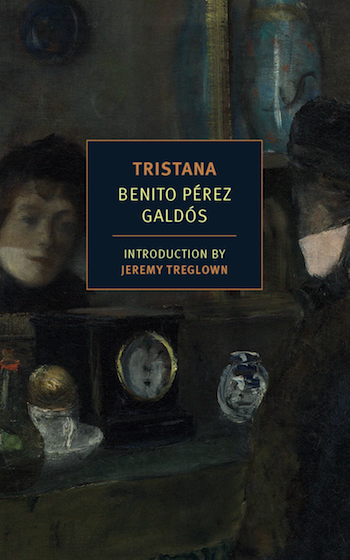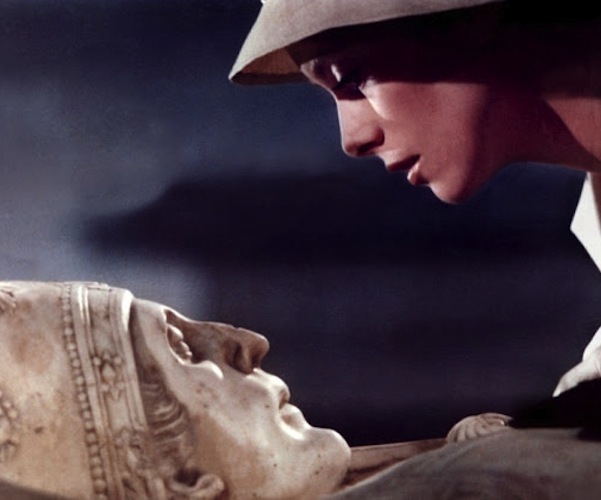Book Review: Benito Pérez Galdós’s “Tristana” — Liberation, Though Off-Kilter
Tristana is Ibsen’s Doll’s House played as a gaunt farce, a vision of feminism as icy egotism rather than individual liberation.
Tristana by Benito Pérez Galdós. Translated from the Spanish by Margaret Jull Costa. Introduction by Jeremy Treglown. NYRB Classics Original, 171 pages, 14.95.

By Bill Marx
In an essay in his collection Where Have You Been? Michael Hofmann states that “none of the Moderns saw very much of the nineteenth century,” but notes that “there is an odd twilit group of writers who straddle the centuries but who carry any amount of nineteenth-century baggage with them.” For Hofmann, the group would include poets such as W.B. Yeats (born in 1865), C.P. Cavafy (1863), and Rainer Maria Rilke (1875), and prose writers Arthur Schnitzler (1862), Anton Chekhov (1860), Knut Hamsun (1859), and Italo Svevo (1861). These authors “are on the cusp. They are still sequential, social writers. They come before abstraction, atonality, anomie, and the cult of difficulty. The novel is not yet part poem, part essay… things may be out of kilter – Chekhov and Yeats are largely about that – but they still believe in kilter. At the very least, they remember it.”
To that group I would add the Spanish writer Benito Pérez Galdós (1843-1920), whose explorations of bourgeois meltdown draw on the meta-fictional satire of Cervantes, the rich melodrama of Balzac, and the sociological detail of Zola. Unlike the latter, Galdós brings a wry playfulness to his realism; the off-kilter spin he puts on kilter makes him one of Hofmann’s twilit Moderns. His being an author that sits “betwixt and between” might account for some of our neglect of his novelistic talents, though the quality of the translations might also be a reason, as well as the fact that Galdós never entered the literary mainstream (Cervantes’s Don Quixote overshadows Spanish prose). His admirers are not afraid of making huge claims for what we are missing — critic Frederic Jameson insists that “if Zola is the Wagner of nineteenth-century realism (and George Eliot perhaps its Brahms), then Benito Pérez Galdós is its Shakespeare, or at least the Shakespeare of the late comedies and romances.”
Jameson’s mix of musicians and writers is confusing (wouldn’t Galdós be Mahler in this scenario?), but the Spanish novelist should be better known. To give you a sense of how nimbly Galdós teeter-totters between the centuries: surrealist director Luis Buñuel based two films on Galdós novels — 1958’s Nazarín, a biting satire of Christianity, and 1970’s Tristana, which was first published in 1892 and has finally been translated into English (with smooth dexterity) by Margaret Jull Costa. The narrative’s dark humor revolves around a pair of misconceived efforts to rise above the pedestrian. Tristana is a late Shakespearean romance gone delightfully sour: here the supernatural comes to the ironic rescue of restless characters who can’t leave the prison house of the self: dreams of freedom from convention and nature turn out to be self-defeating illusions, escape attempts that Galdós treats with a sort of antic sympathy. This is Ibsen’s Doll’s House played as a gaunt farce, a vision of feminism as icy egotism rather than individual liberation.
An old roué, Don Lope, arranges for his final sexual conquest when, after he impoverishes himself paying off the debts of an old friend, he adopts Tristana, the man’s lovely young daughter. He rules her with a respectable and genial form of tyranny — he is both a generous father figure and a manipulative predator, willing to live in genteel poverty given that he is compensated by his memories of trysts past and his attractive trophy, which bolsters his self-esteem. (Galdós mischievously characterizes Don Lope as a quixotic figure.) The innocent Tristana accepts being treated as a prized possession until she is awakened to her compromised situation and struggles to escape:
… she saw her situation with absolute clarity, as well as her own sad lot in humanity; she felt something had slipped unexpectedly through the doors of her soul: pride, an awareness that she was no ordinary person; she was surprised by the growing hubbub in her intellect, saying, ‘Here I am. Haven’t you noticed the grand thoughts I have?’ And the doll’s stuffing was gradually changing into the blood and marrow of a woman, she began to find the mean little life she led in the grip of Don Lope Garrido both boring and repugnant.
A very 19th-century setup: where is a woman longing for freedom and excitement to go? Galdós’s response takes a surprisingly sardonic direction. Like Don Lope, Tristana is determined to rise above the ordinary, to have all or nothing: “Give me life, health, love, and everything I desire.” She is extremely intelligent as well as artistically talented, but beset with insecurities and hobbled by having to establish a career in a society that has no outlet for her ambitions and condemns her immoral upbringing. She impulsively falls in love with a young painter, Horacio, who, despite his workhouse childhood, turns out to be as run-of-the-mill as they come. An intense, obsessive courtship is followed by a crucial separation: when Horacio writes to her that he finds contentment living out in the country, Tristana sees just how far this man (and physicality itself?) falls short of her impossible ideals of fulfillment.

Catherine Deneuve as the title character in Luis Buñuel’s film version of “Tristana.”
Nature provides the ironic capstone to her disappointment with existence: Tristana’s leg becomes diseased and must be amputated. She withdraws from Horacio and finds a bittersweet solace with Don Lope, who forsakes the sensual in order to assist Tristana’s embrace of an apparently joyous solitude: “Distance had come to be one of the most voluptuous aspects of the subtle love striving to detach itself from all sensory influence.” If this is feminist fable, then Galdós has come up with a fascinating variation: can the “subtle love” of contentment be found only through abnegation? Does freeing the soul from desire bring happiness, or it is just another form of death-in-life, the sadness (tristeza) at the heart of things?
Like most of Galdos’s novels, Tristana‘s structure is haphazard and lumpy, moving along by way of awkward lurches of the narrative. In addition, Tristana’s ecstatic states of mind (such as her over-the-top dreams of glory and love) are spelled out at excessive length — fewer servings of her eccentricity would have been more effective, particularly during an extended epistolary exchange between Tristana and Horacio. But that just means that Galdós is no Flaubert. What we have is valuable enough, this time around in minor key — a crepuscular vision that see-saws between the old and the new.
Bill Marx is the Editor-in-Chief of The Arts Fuse. For over three decades, he has written about arts and culture for print, broadcast, and online. He has regularly reviewed theater for National Public Radio Station WBUR and The Boston Globe. He created and edited WBUR Online Arts, a cultural webzine that in 2004 won an Online Journalism Award for Specialty Journalism. In 2007 he created The Arts Fuse, an online magazine dedicated to covering arts and culture in Boston and throughout New England.
Tagged: 19th century Spanish literature, Benito Pérez Galdós, Margaret Jull Costa, NYRB Classics Original, translation

There’s a tiresome review of this book on Music & Literature — the reviewer tells us that “a reader who is only partially invested in nineteenth-century realism and looking for this type of story would be better off reading or rereading Madame Bovary and The Portrait of a Lady.” Well, yes — but as John Berryman said, there are so many more second-rate novels than first-rate ones, and most of the latter are not all that they are cracked up to be. But the critic does include this interesting tidbit about Buñuel’s choice to make a film of Tristana: “He cryptically explained: “Tristana is among Galdós’s worst novels, of the ‘I love you, my little pigeon’ genre, very kitsch. The only thing that interested me was the detail of the amputated leg.” Did the director read the book?
One also wonders whether the NPR reviewer read the book very carefully — this blurb-ridden critique must have come from the pen of a harried intern. “Poetry and philosophy at its crux, the novel is a bold and telling illustration of 19th century Spain”;”Even more interesting is the way Pérez Galdós writes about women, with veiled rants about their mistreatment that border on modern feminism”; “Told in sophisticated yet enveloping prose, Tristana is a treasure that should not be overlooked.” I hope this book gets more considerate and thoughtful reviews than what I have seen so far … Galdós deserves better.